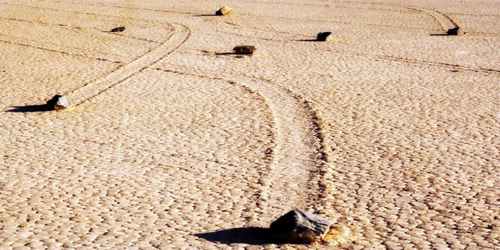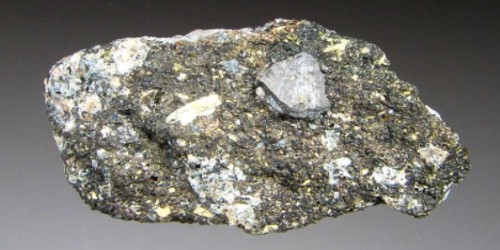For many years, the ‘sailing stones’ of Death Valley represented one of the most curious mysteries that scientists had never been able to solve…until recently, that is. Perhaps the sailing stones kept their secret for so long because they’re so hard to reach.
‘Sailing Stones’, also known as ‘sliding rocks’, ‘walking rocks’, ‘rolling stones’, and ‘moving rocks’, are a geological phenomenon where rocks move and inscribe long tracks along a smooth valley floor without human or animal intervention. The movement of the rocks occurs when large ice sheets a few millimeters thick and floating in an ephemeral winter pond start to break up during sunny days. Frozen during cold winter nights, these thin floating ice panels are driven by wind and shove rocks at speeds up to 5 meters per minute.
Located in a remote area of California’s Death Valley National Park, the heavy stones appear to move across the dried lake bed known as Racetrack Playa, leaving a trail behind them in the cracked mud. The rocks’ apparent movement has been blamed on everything from space aliens and magnetic fields to pranksters. But no one has actually seen the rocks move, which only adds to the mystery.
The Racetrack’s stones speckle the playa floor, predominantly in the southern portion. Historical accounts identify some stones around 100m (300 ft) from shore, yet most of the stones are found relatively close to their respective originating outcrops. Three lithologic types are identified: (1) syenite, found most abundant on the west side of the playa; (2) dolomite, sub-rounded blue-gray stones with white bands; and (3) black dolomite, the most common type, found almost always in angular joint blocks or slivers. This dolomite composes nearly all stones found in the southern half of the playa and originates at a steep promontory, 260m (850 ft) high, paralleling the east shore at the south end of the playa. Intrusive igneous rock originates from adjacent slopes (most of those being tan-colored feldspar-rich syenite). Tracks are often up to 100m (330 ft) long, about 8 to 30 cm (3 to 12 in) wide, and typically much less than 2.5 cm (1 in) deep. Most moving stones range from about 6 to 18 in (15 to 46 cm) in diameter.

(Sailing Stones)
Scientists have tried to solve the puzzle of the sailing stones for decades. Some researchers thought that dust devils might move the rocks, some of which weigh as much as 700 lbs. (318 kilograms). Other researchers believed the strong winds that frequently whip across the vast lake bed could cause the rocks to slide across the ground. These and other theories were eventually disproved, leaving scientists without an explanation.
In some cases, the rock’s trails were measured to be as long as 820 feet (250 meters). Some of the trails formed a graceful curve, while other trails created a straight line, then an abrupt shift to the left or right, which further baffled researchers.
Stones with rough bottoms leave straight striated tracks, while those with smooth bottoms tend to wander. Stones sometimes turn over, exposing another edge to the ground and leaving a different track in the stone’s wake. Trails differ in both direction and length. Rocks that start next to each other may travel parallel for a time, before one abruptly changes direction to the left, right, or even back to the direction from which it came. Trail length also varies two similarly sized and shaped rocks may travel uniformly, then one could move ahead or stop in its track.
In 2014, scientists were able to capture the movement of the stones for the first time using time-lapse photography. The results strongly suggest that the sailing stones are the result of a perfect balance of ice, water, and wind. In the winter of 2014, rain formed a small pond that froze overnight and thawed the next day, creating a vast sheet of ice that was reduced by midday to only a few millimeters thick. Driven by a light wind, this sheet broke up and accumulated behind the stones, slowly pushing them forward.
Scientists who studied the rocks noticed that not all of the rocks moved. The ones that did move only moved every two or three years. Further, complicating things was the fact that the stones that moved never moved at the same time or in the same direction.
On the 19th of September 2016, Kurt Lawson of PetaPixel reported that the racetrack had been defaced with tire tracks, and the initials ‘D’ and ‘K’ were carved into one of the rocks. Then, on the 16th of March 2018, Las Vegas Review-Journal reported that volunteers had cleaned the tire tracks from the Racetrack using gardening tools and 750 gallons of water.
Information Source:
















